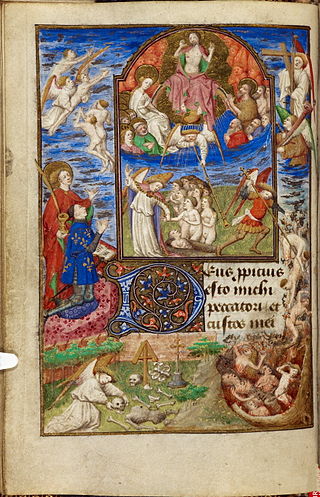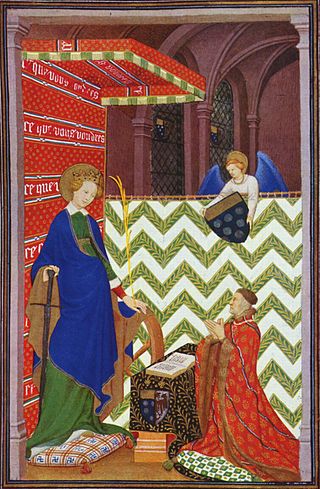
Books of hours are Christian prayer books which were used to pray the canonical hours. The use of a book of hours was especially popular in the Middle Ages and as a result, they are the most common type of surviving medieval illuminated manuscript. Like every manuscript, each manuscript book of hours is unique in one way or another, but most contain a similar collection of texts, prayers and psalms, often with appropriate decorations, for Christian devotion. Illumination or decoration is minimal in many examples, often restricted to decorated capital letters at the start of psalms and other prayers, but books made for wealthy patrons may be extremely lavish, with full-page miniatures. These illustrations would combine picturesque scenes of country life with sacred images.

The Holy Family consists of the Child Jesus, the Virgin Mary and Saint Joseph. The subject became popular in art from the 1490s on, but veneration of the Holy Family was formally begun in the 17th century by Saint François de Laval, the first bishop of New France, who founded a confraternity.

Simon Bening was a Flemish miniaturist, generally regarded as the last major artist of the Netherlandish tradition.

Simon Marmion was a French and Burgundian Early Netherlandish painter of panels and illuminated manuscripts. Marmion lived and worked in what is now France but for most of his lifetime was part of the Duchy of Burgundy in the Southern Netherlands.

Pietro Paolini, called il Lucchese was an Italian painter of the Baroque period. Working in Rome, Venice and finally his native Lucca, he was a follower of Caravaggio to whose work he responded in a very personal manner. He founded an Academy in his hometown, which formed the next generation of painters of Lucca.

The Master of the Saint Bartholomew Altarpiece was an Early Netherlandish painter active in Germany, mostly Cologne, between 1475/1480 and 1510. Despite his anonymity, he is one of the most recognizable artists of the early Renaissance period in German art.

The Master of the Llangattock Hours was a Flemish manuscript painter active between 1450 and 1460. He is one of at least eight artists who contributed to the Llangattock Hours, a book of hours now in the J. Paul Getty Museum collection; his name is derived from the fact that he appears to have been the primary artist, and was assigned in turn after the name of a previous owner of the book. He was active in the generation after Jan van Eyck and shows a great deal of his influence, at times directly copying the elder master's compositions. Nevertheless, his figures are small and stiff, set in landscapes or in awkwardly-drawn architectural settings. His color schemes are dense, with little indication of an understanding of lighting techniques. It is believed that the Master lived and worked in Bruges, given his reliance on the work of earlier local masters, his work on the Turin-Milan Hours, and collaboration with other local painters, such as Willem Vrelant.

The Master of Anthony of Burgundy was a Flemish miniature painter active in Bruges between about 1460 and 1490, apparently running a large workshop, and producing some of the most sophisticated work of the final flowering of Flemish illumination. He was first identified by Winkler in 1921; his name is derived from one of his most elevated patrons, Anthony of Burgundy, Philip the Good's illegitimate son, though he also worked for the Dukes and other bibliophiles in Burgundian court circles, who had already been allocated "Masters" by art historians. His contributions to the heavily illustrated Froissart of Louis of Gruuthuse from the early 1470s, on which several of the leading illuminators of the day worked, show him excelling some more famous names, like Loiset Lyédet. The young Master of the Dresden Prayerbook worked as his assistant on this book, suggesting he was an apprentice; a number of other anonymous masters have been postulated as his pupils. Other works are in the libraries of Paris, Wrocław, Philadelphia, Munich, Cambridge University Library and elsewhere.

The Master of James IV of Scotland was a Flemish manuscript illuminator and painter most likely based in Ghent, or perhaps Bruges. Circumstantial evidence, including several larger panel paintings, indicates that he may be identical with Gerard Horenbout. He was the leading illuminator of the penultimate generation of Flemish illuminators. The painter's name is derived from a portrait of James IV of Scotland which, together with one of his Queen Margaret Tudor, is in the Prayer book of James IV and Queen Margaret, a book of hours commissioned by James and now in Vienna. He has been called one of the finest illuminators active in Flanders around 1500, and contributed to many lavish and important books besides directing an active studio of his own.

The Ravenelle Painter, also known as the Master of the Book of Hours of Johannete Ravenelle, the Ravenelle Master or the First Master of the Bible Historiale of Jean de Berry, was a French manuscript illuminator active between 1390 and 1405. Little is known about him. In a 2002 dissertation, Eva Lindqvist Sandgren used stylistic comparison to identify this artist as the illuminator of a book of hours now in the Uppsala University Library, the Ravenelle Hours. This identification is now widely accepted. An earlier notname for the same artist derives from a manuscript of the Bible Historiale, now held by the Bibliothèque nationale de France in Paris, in which he painted several miniatures. The manuscript was once owned by John, Duke of Berry, and with most books containing other work ascribed to the artist seems to have been produced in Paris. This would indicate that the artist lived and worked there, producing large secular works as well as religious treatises written in vernacular French.

The Turin–Milan Hours is a partially destroyed illuminated manuscript, which despite its name is not strictly a book of hours. It is of exceptional quality and importance, with a very complicated history both during and after its production. It contains several miniatures of about 1420 attributed to an artist known as "Hand G" who was probably either Jan van Eyck, his brother Hubert van Eyck, or an artist very closely associated with them. About a decade or so later Barthélemy d'Eyck may have worked on some miniatures. Of the several portions of the book, that kept in Turin was destroyed in a fire in 1904, though black-and-white photographs exist.

The Dunois Master, also called Chief Associate of the Bedford Master was a French manuscript illuminator believed to have been active between about 1430 and about 1465. His name comes from a book of hours made for Jean de Dunois now in the British Library. He worked in association with the Bedford Master, in whose workshop he seems to have served; scholars consider him to be the most talented of the Bedford Master's assistants. He is usually assumed to have taken over the workshop when the Bedford Master ceased to be active, or to have set up his own with some of the artists. His style is characterized by soft modeling of forms, and a fondness for pale colors and shell gold.

The Boucicaut Master or Master of the Hours for Marshal Boucicaut was an anonymous French or Flemish miniaturist and illuminator active between 1400 and 1430 in Paris. He worked in the International Gothic style.

The Taleides Painter was an Attic vase painter of the black-figure style, active in the second half of the 6th century BC. His conventional name is derived from his close cooperation with the potter Taleides, many of whose vases he painted. He also worked for the potter Timagoras.

The Nelson Rooms is a grade II listed building in Monmouth, Monmouthshire, Wales. It is in the historic Glendower Street and Agincourt Street neighbourhood, within the medieval town walls. The building initially served as a gymnasium and was a gift from Lady Llangattock to the town of Monmouth. In 1924, after the benefactor's death, it reopened as the Nelson Museum, and showcased the collection of memorabilia related to Admiral Horatio Nelson that had been amassed by the baroness. The Nelson Museum moved to new quarters at the Market Hall in 1969. The former gymnasium and museum is now an apartment building.

The Book of Hours of Simon de Varie is a French illuminated manuscript book of hours commissioned by the court official Simon de Varie, with miniatures attributed to at least four artists; hand A who may have been a workshop member of the Bedford Master, the anonymous illustrators known as the Master of Jean Rolin II, the Dunois Master and the French miniaturist Jean Fouquet. It was completed in 1455 and consists of 49 large miniatures and dozens of decorative vignettes and painted initials, which total over 80 decorations. Fouquet is known to have contributed six full leaf illuminations, including a masterwork Donor and Virgin diptych. A number of saints appear - Saint Simon is placed as usual alongside Saint Jude ; other pages feature saints Bernard of Menthon, James the Greater and Guillaume de Bourges.

The Pseudo-Jacquemart was an anonymous master illuminator active in Paris and Bourges between 1380 and 1415. He owed his name to his close collaboration with painter Jacquemart de Hesdin.

The Hours of Louis XII was an illuminated manuscript book of hours produced by Jean Bourdichon for Louis XII of France. It was begun in 1498 or 1499, going by the king's age of 36 given below his portrait; he became king on 7 April 1498. The book reached England, where it was broken up around 1700. Now only parts of it survive – in total sixteen full-page miniature paintings, two sheets of text and fifty-one sheets of text bound in the wrong order as a thin volume.

The Master of the Brussels Initials, previously identified with Zebo da Firenze, was a manuscript illuminator active mainly in Paris. He brought Italian influences to French manuscript illumination and in that way played an important role in the development of the so-called International Gothic style. Decorations by the artist appear in several different works, illustrated by several different artists, and some attributions have been questioned. A corpus of works attributable to the Master of the Brussels Initials was initially identified by art historians Otto Pächt and Millard Meiss. The artist's style was inventive, bright and lively, and G. Evelyn Hutchinson has also pointed out the unusually realistic depictions of minute wildlife found in his work. At one point the bibliophile John, Duke of Berry employed the Master of the Brussels Initials.



















